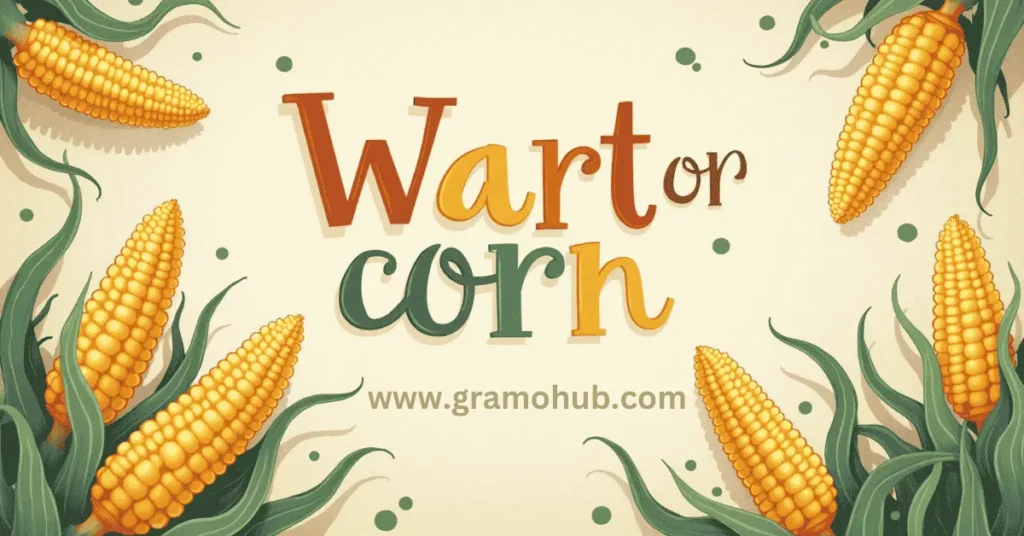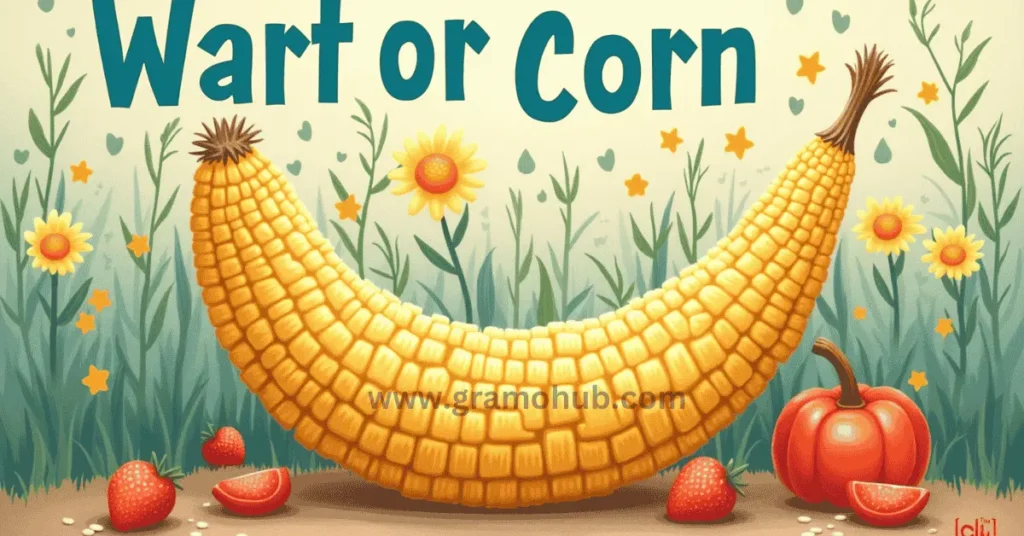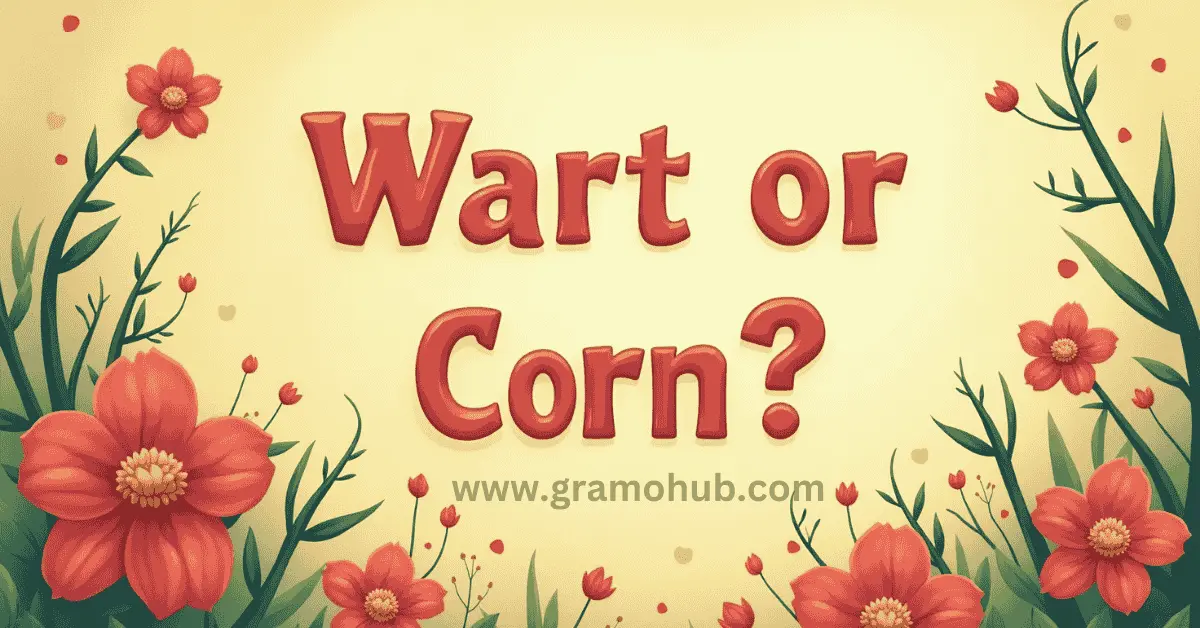Introduction: Wart or Corn? Understanding the Difference
Many people struggle to identify whether they have a wart or a corn. These skin conditions appear similar but have different causes, symptoms, and treatments. Warts develop due to HPV infection, while corns result from constant friction and pressure.
Misidentifying them may lead to ineffective treatment, prolonging discomfort. Warts are highly contagious, whereas corns are not infectious but often painful. Proper identification is crucial to finding the right cure and preventing recurrence.
This guide explores everything you need to know about warts and corns. You’ll learn how to tell them apart, treat them effectively, and prevent future occurrences. By the end, you’ll have a clear understanding of both conditions.
Wart or Corn? Key Differences Explained
Causes of Warts and Corns
Warts are caused by human papillomavirus (HPV), which enters the skin through small cuts. This virus triggers excess skin cell growth, forming rough, raised bumps. Because HPV is contagious, warts can spread through direct contact or contaminated surfaces.
Corns, however, are not caused by a virus. They form due to repeated pressure or friction on the skin. Wearing tight shoes, walking barefoot, or using improper footwear can lead to thickened, hardened skin in pressure-prone areas.
Unlike warts, corns do not spread from person to person. Instead, they appear on weight-bearing areas such as the toes, soles, and sides of the feet. Long-term friction can cause corns to grow deeper, leading to pain and discomfort.
Appearance and Texture
Warts have a rough, bumpy texture with tiny black dots, which are clotted blood vessels. These black dots are a key distinguishing feature of warts. They may be round, irregular, and vary in size, sometimes appearing in clusters.
Corns are hard, thickened patches of skin that feel dense and firm. They often have a clear, central core surrounded by yellow or white dead skin. Corns are usually dry and flaky, whereas warts tend to be moist or slightly inflamed.
Unlike warts, corns do not contain black dots. Warts may bleed if scratched, but corns remain dry and solid. Warts may also feel tender when squeezed from the sides, while corns hurt when direct pressure is applied.
Pain and Sensitivity
Warts can be painful, especially plantar warts, which grow inward due to walking pressure. They may cause discomfort when standing or pressing on the affected area. Some warts, like periungual warts, grow around nails and cause irritation.
Corns often cause sharp, localized pain because they press against deeper skin layers. They can become extremely tender, making walking or wearing shoes uncomfortable. Unlike warts, corns do not cause itching or spontaneous pain.

While both conditions can be painful, warts tend to cause mild, throbbing pain, whereas corns feel like a hard lump pushing into the skin. Proper footwear and skin care can reduce corn-related discomfort significantly.
What Causes Warts? The Role of HPV
How HPV Infects the Skin
HPV enters the skin through small cuts, abrasions, or cracks, allowing the virus to infect deeper layers. Once inside, it triggers excessive keratin production, leading to wart formation. The virus thrives in moist environments like public showers, pools, and gyms.
Different HPV strains cause different types of warts. Common warts appear on fingers and hands, while plantar warts develop on the soles of the feet. Some HPV strains cause genital warts, which require specialized treatment.
People with weakened immune systems are more prone to HPV infections. Conditions like diabetes, autoimmune diseases, or prolonged stress increase wart susceptibility. Children and teenagers are also at higher risk due to frequent exposure.
Ways Warts Spread
Warts spread through direct contact with infected skin. Touching a wart and then another part of the body can transfer the virus. Sharing towels, razors, socks, or nail clippers can also spread HPV.
Public places like swimming pools, locker rooms, and gym floors are common sources of wart infection. The virus survives on surfaces for extended periods, making barefoot exposure risky. Wearing protective footwear can reduce the risk.
Some people carry HPV without showing symptoms. Even if a wart is removed, HPV may remain dormant in the skin, causing warts to return later. Keeping feet clean and dry helps minimize re-infection chances.
Who is at Risk?
- Children and teens due to frequent skin injuries and exposure.
- People with weakened immune systems, such as those with HIV or cancer.
- Individuals with sweaty feet, as moisture allows HPV to thrive.
Proper hygiene, avoiding direct wart contact, and boosting immune health help prevent wart infections.
What Causes Corns? Friction and Pressure Explained
Common Causes of Corns
Corns develop from repeated friction or pressure against the skin. Wearing tight shoes, high heels, or shoes without socks increases the risk. Walking or running for long periods exacerbates corn formation.
Foot deformities like bunions, hammertoes, or flat feet increase friction points, making corns more likely. Improper gait and posture can also place excessive pressure on certain foot areas, causing thickened skin to develop.
Over time, the body forms corns as a protective response to pressure. However, without proper treatment, they can become deeper and more painful. Unlike warts, corns do not spread or result from a viral infection.
Types of Corns
- Hard Corns – Dense, compact skin layers found on toes and soles.
- Soft Corns – Moist, rubbery corns between toes due to excess sweat.
- Seed Corns – Small, scattered corns on pressure points of the foot.
Each type requires different care, but all result from friction or pressure buildup.

Preventing Corn Formation
- Wear properly fitted shoes with ample toe space.
- Use soft padding or insoles to reduce pressure on feet.
- Moisturize feet daily to prevent excess dryness and skin thickening.
Regular foot care helps prevent corns and keeps feet smooth and pain-free.
How to Treat Warts and Corns
Best Treatments for Warts
- Salicylic Acid – Exfoliates infected skin over time.
- Cryotherapy (Freezing) – Kills wart tissue using liquid nitrogen.
- Laser Therapy or Surgery – Removes persistent warts with medical intervention.
Best Treatments for Corns
- Pumice Stone – Gently files away thickened skin after soaking.
- Cushion Pads – Reduces pressure and prevents further irritation.
- Foot Orthotics – Helps correct gait issues to prevent recurring corns.
Final Thoughts: Keeping Skin Wart-Free and Corn-Free
Identifying warts and corns correctly ensures proper treatment and faster recovery. Warts stem from a viral infection, while corns develop from pressure and friction. Knowing their differences helps prevent unnecessary pain and ineffective treatments.
Good foot hygiene, wearing the right shoes, and avoiding direct skin contact with infected surfaces reduce the chances of developing warts or corns. If symptoms persist, consult a doctor for specialized treatment.
With the right care, you can keep your feet healthy, smooth, and pain-free. Always take preventive measures to avoid these common skin conditions.
FAQs
Are warts contagious?
Yes, warts spread through skin contact or shared surfaces.
Can corns go away on their own?
Mild corns may fade with reduced pressure, but severe cases need treatment.
Do warts or corns cause infections?
Warts rarely cause infections, but corns can get infected if left untreated.
This guide covers everything about warts and corns, helping you choose the best treatment and prevention strategies.

